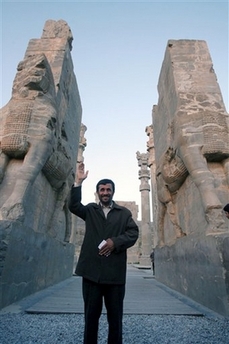Iran dam said to threaten ancient sites
(AP)Updated: 2007-04-20 10:49
TEHRAN, Iran - Iranian engineers began filling a new dam Thursday as archaeologists warned that its reservoir will flood newly discovered antiquities and could damage Iran's grandest site, the ancient Persian capital of Persepolis.
At the inauguration ceremony, attended by Energy Ministry officials, pipes were opened for water to start flowing into an artificial lake created by the dam spanning the Sivand River, 520 miles south of the capital, Tehran. The lake's waters will be used to irrigate the area's farms.
Iranian state-run television said the dam was opened "on the order of the President" Mahmoud Ahmadinejad, but the hard-line Iranian leader did not attend the inauguration.
The launch was delayed for months to give international archaeological teams time to conduct excavations in the area of the planned reservoir after an appeal from the United Nations Educational, Scientific and Cultural Organization.
The work yielded significant discoveries such as a road believed to be the Royal Passage of the Achaemenids, a powerful dynasty in ancient Persia in the 6th century B.C., as well as an Achaemenid village with a cemetery and inhabited caves dating back 7,000 years.
Iranian intellectuals and activists condemned the Tehran government for going ahead with the dam, calling it a "stupidity."
Archaeologists say flooding from the dam will submerge the Royal Passage, which linked Persepolis to Susa, two capital cities in ancient Persia, as well as some of the 130 ancient sites along the Tang-e-Bolaghi, a mountain path that crosses the Sivand River.
There are also concerns that humidity, spreading through underground water from the dam, could damage nearby Persepolis.
The sprawling ruins, Greek for "City of Persians," are famed for the grand double stairway rising to a wide, terraced audience hall with 72 columns. Sacked by Alexander the Great about 330 B.C., the old city is visited by millions every year, mostly Iranians but also foreigners.
Experts also worry about Pasargadae, an ancient capital built by Cyrus the Great sometime after 550 B.C. that holds his tomb.
Both Persepolis and Pasargadae, only 19 miles and 5 miles away from the dam, are on UNESCO's list of World Heritage Sites.
Iran's Islamic-oriented government has not shown much concern for cultural sites from the Persian era, unlike the country's more recent Muslim monuments.
The official IRNA news agency quoted Vice President Rahim Mashaei, who is also head of Iran's Cultural Heritage Organization, as saying Thursday that the "opening of the Sivand Dam is no danger for Pasargadae" but did not mention the Royal Passage or Persepolis.
Archaeologist Parviz Varjavand said "irreplaceable human heritage" will be lost.
"This ruling establishment gives no value to Iran's cultural heritage. It is an act of stupidity and obstinacy," he said.
|
||
|
||
|
|

